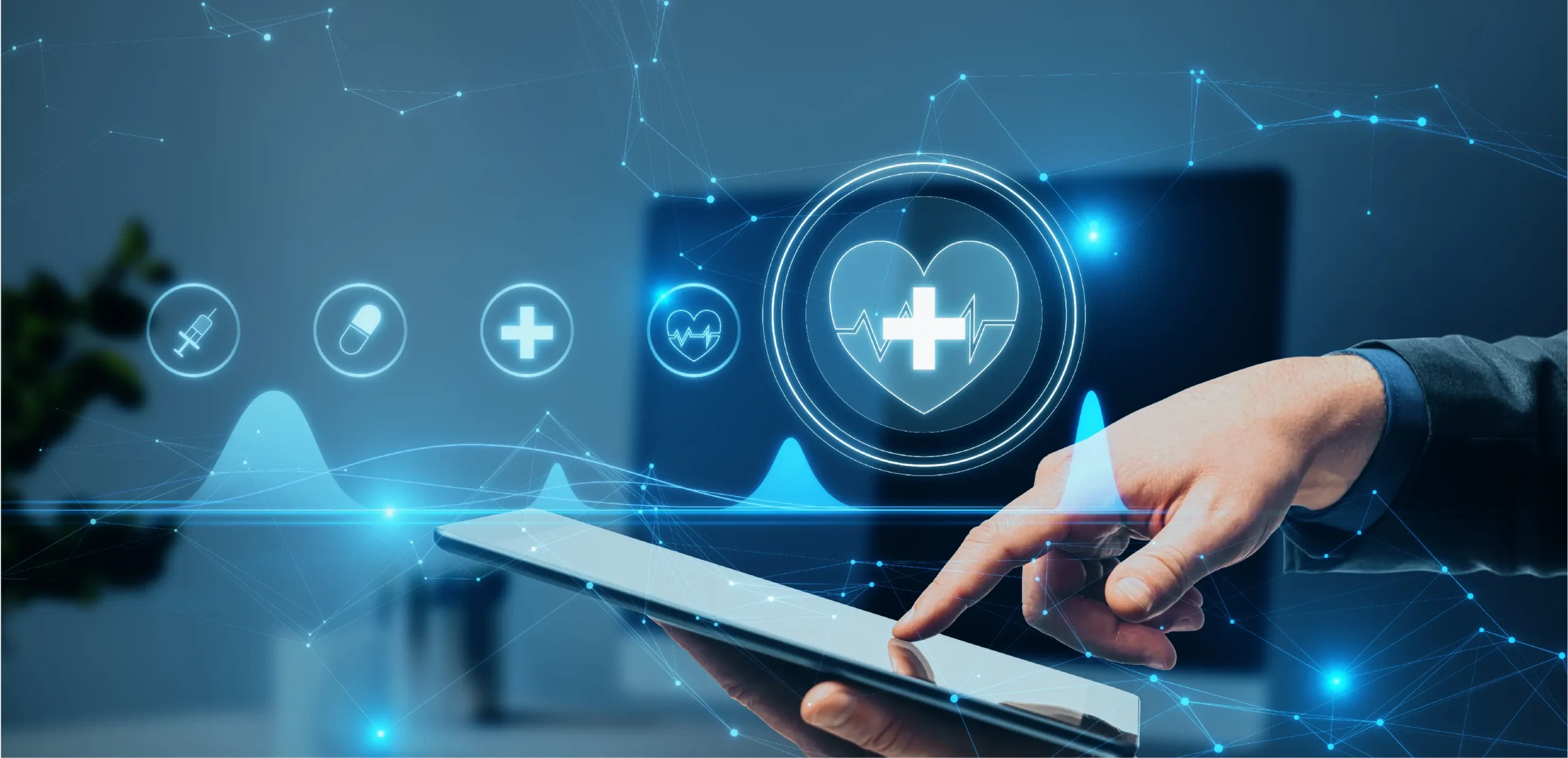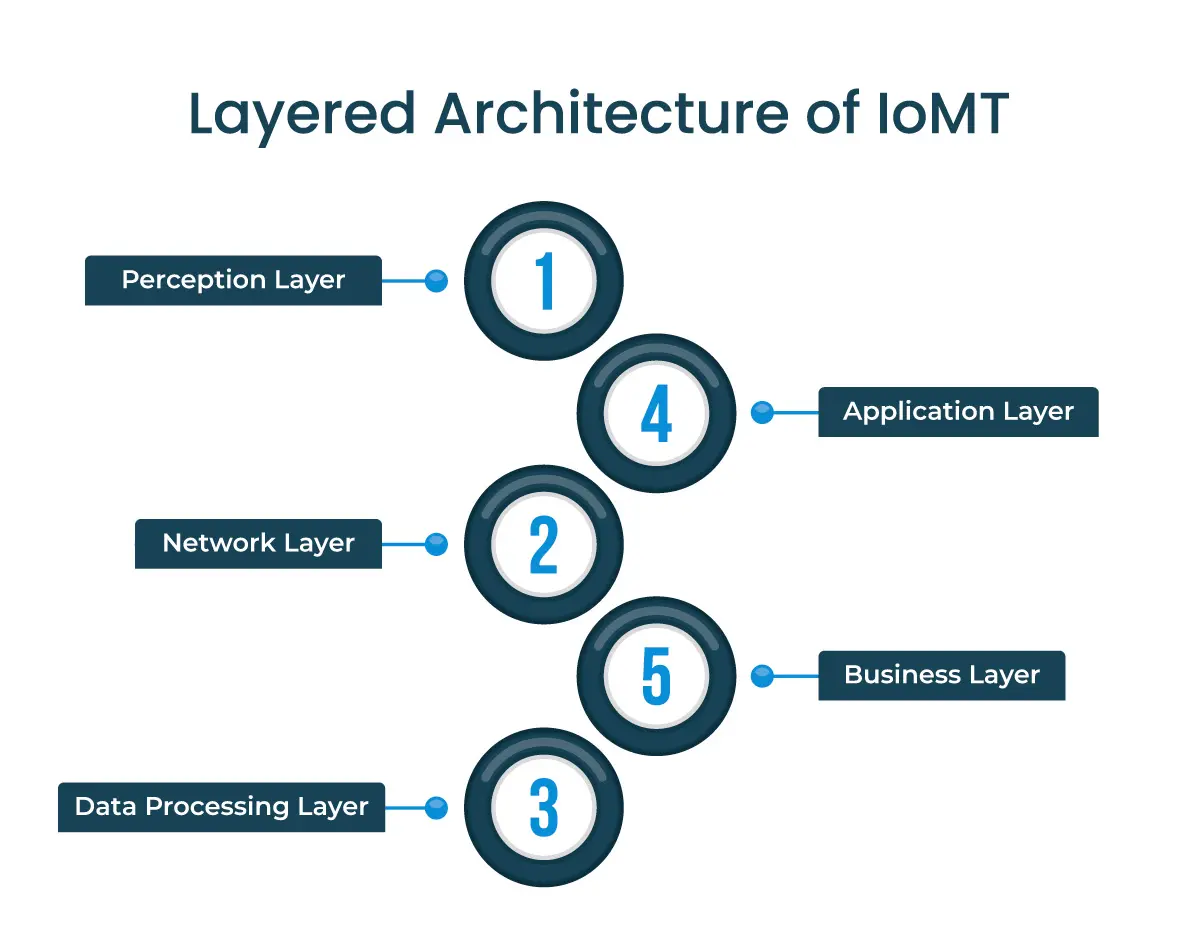

The landscape of healthcare delivery is undergoing a profound transformation, driven by the synergistic power of Remote Patient Monitoring (RPM) and the Internet of Medical Things (IoMT). This dynamic duo is revolutionizing how patients receive care, empowering individuals with real-time health data and enabling healthcare providers to monitor and manage conditions remotely.
In this exploration of RPM and IoMT, we will delve into the ways in which these technologies are reshaping the healthcare industry, enhancing patient outcomes, and creating a more efficient, patient-centric model of care.
The Internet of Medical Things (IoMT) refers to a network of medical devices, software applications, and health systems that are interconnected through computer networks. These devices are equipped with sensors, actuators, and communication technology, enabling them to collect, transmit, and analyze health data in real time.
IoMT encompasses a wide range of devices, from wearables like smartwatches and fitness trackers to implanted devices like pacemakers and insulin pumps. By connecting these devices to the internet, IoMT facilitates the seamless exchange of health information between patients, healthcare providers, and other stakeholders, thereby transforming the way healthcare is delivered and managed.
This interconnected ecosystem enables remote patient monitoring, personalized medicine, improved clinical decision-making, and enhanced patient engagement, ultimately leading to better health outcomes and a more efficient healthcare system.
IoMT serves as the backbone for remote patient monitoring (RPM) by creating a connected ecosystem that enables seamless communication and data exchange between patients and healthcare providers.
IoMT devices, such as wearables, sensors, and implants, continuously collect a wide range of health data, including vital signs (e.g., heart rate, blood pressure, glucose levels), activity levels, sleep patterns, and medication adherence. This data is gathered in real time, providing a comprehensive view of the patient’s health status.
IoMT devices are equipped with wireless communication technologies like Bluetooth, Wi-Fi, or cellular networks, allowing them to transmit the collected health data securely to cloud-based platforms or healthcare provider systems. This ensures that the data is accessible to both patients and their care teams, regardless of their location
RPM platforms use sophisticated algorithms and analytics tools to process the incoming data. This analysis can generate insights into patient health trends, identify potential issues, and trigger alerts for healthcare providers if necessary. The data is often presented in user-friendly dashboards, making it easy for clinicians to interpret.
Armed with real-time or near-real-time data, healthcare providers can remotely monitor patients’ conditions, adjust treatment plans, offer personalized guidance, and even intervene proactively to prevent complications. For instance, a spike in blood sugar levels could trigger a message from a healthcare provider to a diabetic patient.
The Internet of Medical Things (IoMT) is a complex ecosystem, and understanding its layered architecture is crucial to grasping how it functions and delivers value in healthcare. Each layer plays a distinct role in enabling the seamless flow of data and ensuring the smooth operation of IoMT systems.

1.Perception Layer:
This is the foundation of IoMT, where data is collected. It consists of a wide array of medical devices and sensors, such as wearables (smartwatches, fitness trackers), implantable devices (pacemakers, glucose monitors), and environmental sensors (temperature, humidity). These devices gather raw health data from patients and their surroundings.
2.Network Layer:
This layer is responsible for transmitting the collected data. It encompasses various communication technologies like Bluetooth, Wi-Fi, cellular networks (4G/5G), and even satellite communication for remote areas. The network layer ensures that data flows securely and reliably from the perception layer to the next stage.
3.Data Processing Layer:
Once the data reaches this layer, it is processed, analyzed, and stored. This layer typically resides in the cloud or edge computing devices closer to the data source. It employs advanced algorithms, machine learning models, and data analytics tools to extract meaningful insights from the raw data. This is where patterns are identified, alerts are generated, and decisions are made based on the data.
4.Application Layer:
This layer is where the rubber meets the road. It comprises software applications and user interfaces that interact with the processed data. These applications can range from electronic health records (EHRs) and telemedicine platforms to patient portals and mobile apps. Healthcare providers, patients, and caregivers utilize these applications to access, visualize, and interpret the data for informed decision-making.
Business Layer:
This is the outermost layer, where the value of IoMT is realized. It includes the business models, services, and strategies that healthcare organizations employ to leverage IoMT data. This could involve offering remote patient monitoring services, personalized treatment plans, preventive care programs, or even new revenue streams based on data-driven insights.
The integration of the Internet of Medical Things (IoMT) into Remote Patient Monitoring (RPM) is revolutionizing the healthcare landscape, transforming how patient data is shared and utilized. This dynamic duo offers a convenient and value-based approach that benefits both patients and clinicians alike. Let’s delve into five key benefits of IoMT in RPM:
IoMT-enabled RPM allows clinicians to provide proactive care between appointments. By continuously monitoring patient data outside the clinical setting, healthcare providers can identify early signs of complications and focus on preventive measures. RPM platforms can also instantly alert clinicians when patient readings exceed set thresholds, enabling timely interventions that minimize the need for costly hospital admissions and emergency room visits.
RPM devices are designed to be user-friendly, requiring minimal effort from patients. This is crucial, as complex or time-consuming treatment plans often lead to non-compliance. Many RPM devices offer simple, intuitive interfaces and automatic data transmission, easing the burden on patients and ensuring consistent monitoring.
A significant advantage of IoMT-powered RPM is the secure collection, transmission, and storage of patient health data. This allows for the rapid development of detailed patient health histories, giving providers a comprehensive understanding of each individual’s condition and enabling more effective treatment plans. FDA-cleared and HIPAA-compliant RPM devices ensure the accuracy and privacy of patient data through encryption and secure communication channels.
RPM devices leverage technologies like Bluetooth, Wi-Fi, and cellular networks to transmit data in real-time, fostering seamless communication between patients and their care teams. This constant connection keeps patients actively engaged in managing their health and allows clinicians to track patient engagement and provide timely support.
IoMT and RPM together expand access to healthcare services. The ability to remotely monitor patients reduces the need for travel, making quality care more accessible to individuals in rural or underserved areas. Patients can easily share their vital sign measurements from home, while providers can access real-time data remotely, ensuring that care is both convenient and efficient.
In summary, the integration of IoMT into RPM is empowering patients, enhancing the efficiency of healthcare delivery, and paving the way for a more proactive, patient-centric approach to healthcare. With its numerous benefits, IoMT is set to play a pivotal role in the future of medicine.
In conclusion, the fusion of Remote Patient Monitoring (RPM) and the Internet of Medical Things (IoMT) represents a paradigm shift in healthcare delivery. This dynamic duo is not only reshaping how we manage chronic conditions and deliver care but also empowering patients to take charge of their health like never before. The IoMT, with its interconnected network of medical devices and sensors, provides the foundation for seamless data collection, transmission, and analysis, while RPM leverages this data to facilitate real-time monitoring, early intervention, and personalized care.
As these technologies continue to evolve and mature, we can anticipate even greater advancements in the future, leading to a healthcare system that is more efficient, effective, and accessible to all. The era of connected healthcare is here, and its potential to transform lives is truly remarkable.
Talk to an Expert Now